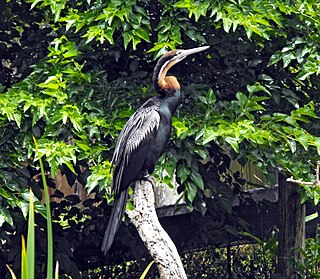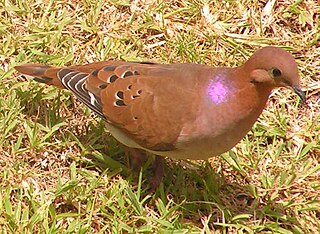
Gaviiformes is an order of aquatic birds containing the loons or divers and their closest extinct relatives. Modern gaviiformes are found in many parts of North America and northern Eurasia, though prehistoric species were more widespread.

The darters, anhingas, or snakebirds are mainly tropical waterbirds in the family Anhingidae, which contains a single genus, Anhinga. There are four living species, three of which are very common and widespread while the fourth is rarer and classified as near-threatened by the IUCN. The term snakebird is usually used without any additions to signify whichever of the completely allopatric species occurs in any one region. It refers to their long thin neck, which has a snake-like appearance when they swim with their bodies submerged, or when mated pairs twist it during their bonding displays. "Darter" is used with a geographical term when referring to particular species. It alludes to their manner of procuring food, as they impale fishes with their thin, pointed beak. The American darter is more commonly known as the anhinga. It is sometimes called "water turkey" in the southern United States; though the anhinga is quite unrelated to the wild turkey, they are both large, blackish birds with long tails that are sometimes hunted for food.

Anas is a genus of dabbling ducks. It includes the pintails, most teals, and the mallard and its close relatives. It formerly included additional species but following the publication of a molecular phylogenetic study in 2009 the genus was split into four separate genera. The genus now contains 31 living species. The name Anas is the Latin for "duck".

The Orinoco goose is a Near Threatened species of waterfowl in the tribe Tadornini of subfamily Anserinae. It is found in every mainland South American country except Chile, French Guiana, Suriname, and Uruguay.

Chloephaga is a genus of sheldgeese in the family Anatidae. Other sheldgeese are found in the genera Alopochen and Neochen.

Elopteryx is a genus of paravian theropod dinosaur based on fragmentary fossils found in Late Cretaceous rocks of Romania. The single species, Elopteryx nopcsai, was known only from very incomplete material until new specimens were reported in the 21st century. Balaur bondoc might represent a junior synonym of this taxon.

The fauna of Barbados comprises all the animal species inhabiting the island of Barbados and its surrounding waters. Barbados has less biodiversity than the other Antilles. Human activities are responsible for the change in the composition of the fauna, in particular, the replacement of native species. Species that are able to adapt to human presence have survived.

Pardirallus is a genus of bird in the family Rallidae. It contains three species native to marshland areas of Southern, Central America and the Caribbean, although fossil evidence indicates they once ranged north to what is now Idaho. They are 25–38 cm long and have a long greenish bill and reddish legs. The spotted rail is blackish-brown with white markings while the other two are brown above and dark grey below.
Torotix is a Late Cretaceous genus of aquatic birds. They lived along the shores of the Western Interior Seaway, but it is not clear whether they were seabirds or freshwater birds, as the genus is only known from a humerus. Consequently, the genus contains only one known species, Torotix clemensi. T. clemensi is represented by a single fossil specimen, a partial humerus recovered from the Lance formation of Wyoming. Its deposits are dated to the very end of the Cretaceous period, 66 million years ago.
Paleontology or palaeontology is the study of prehistoric life forms on Earth through the examination of plant and animal fossils. This includes the study of body fossils, tracks (ichnites), burrows, cast-off parts, fossilised feces (coprolites), palynomorphs and chemical residues. Because humans have encountered fossils for millennia, paleontology has a long history both before and after becoming formalized as a science. This article records significant discoveries and events related to paleontology that occurred or were published in the year 1992.
Paleontology or palaeontology is the study of prehistoric life forms on Earth through the examination of plant and animal fossils. This includes the study of body fossils, tracks (ichnites), burrows, cast-off parts, fossilised feces (coprolites), palynomorphs and chemical residues. Because humans have encountered fossils for millennia, paleontology has a long history both before and after becoming formalized as a science. This article records significant discoveries and events related to paleontology that occurred or were published in the year 1965.
Paleontology or palaeontology is the study of prehistoric life forms on Earth through the examination of plant and animal fossils. This includes the study of body fossils, tracks (ichnites), burrows, cast-off parts, fossilised feces (coprolites), palynomorphs and chemical residues. Because humans have encountered fossils for millennia, paleontology has a long history both before and after becoming formalized as a science. This article records significant discoveries and events related to paleontology that occurred or were published in the year 1959.

Helenodora is an extinct basal onychophoran or lobopodian genus known from the Carboniferous Carbondale Formation of Illinois. The only known species described is H. inopinata. The ecology of this animal is not well known, but it is thought that it may have lived on land and/or underwater.
The Barbados rail is a fossil rail species endemic to Barbados with an undetermined taxonomic status. It was formerly described by Pierce Brodkorb in 1965 as Fulica podagrica. However, this classification has been questioned by Storrs Olson when he described Brodkorb's material anew in 1974. It is only known by Brodkorb's holotype which consists of a humerus and several leg elements including femur, tibiotarsus and tarsometatarsus fragments. The humerus may not be specifically distinct from those of the American coot but most of the femur, tibiotarsus and tarsometarsus fragments are from a yet undescribed larger rail of an undetermined genus not related to Fulica. Olson further assumed that Brodkorb's material might be a composite of several rail species. The bone fragments were unearthed in Late Pleistocene deposits in Saint Philip Parish and Ragged Point on Barbados.

Primobucco is an extinct genus of bird placed in its own family, Primobucconidae. The type species, Primobucco mcgrewi, lived during the Lower Eocene of North America. It was initially described by American paleo-ornithologist Pierce Brodkorb in 1970, from a fossil right wing, and thought to be an early puffbird. However, the discovery of a further 12 fossils in 2010 indicate that it is instead an early type of roller.
Neochen pugil is an extinct species of goose from the Late Pleistocene or possibly the Early Holocene of Brazil. The fossils were discovered by Danish paleontologist Peter Wilhelm Lund near Lagoa Santa, Minas Gerais state, and described by Danish ornithologist Oluf Winge in 1888. It was related to the living Orinoco goose, but much larger.
Neochen debilis is an extinct species of goose from the Middle Pleistocene Belgrano Formation of Argentina. Argentine paleontologist Florentino Ameghino described the species from a tarsometatarsus discovered in La Plata. It was smaller than the extant Orinoco goose.
Gavia howardae is an extinct species of loon from the Piacenzian age from United States. Fossils of this bird were initially found in 1947 by Clifford Kennell in the San Diego Formation, California and were given a name in 1953 by Pierce Brodkorb. These first specimens consisted of humeri bones, which Brodkorb indicated based on the distal end of the humerus were a smaller species of the genus Gavia, with a possible relationship with the pacific loon. More specimens were collected from the same deposits covering the entirety of the wing, some more complete than others. Chandler (1990) described and published these new materials and found G. howardae to be related to the red-throated loon instead. Additional material has been recovered from the Yorktown Formation, North Carolina where in addition more wing bones, there were also remains of the leg and shoulder regions. Based on the overall size of the remains, G. howardae was on average smaller than the red-throated loon, and one of the smallest species of Neogene loons from North America.









